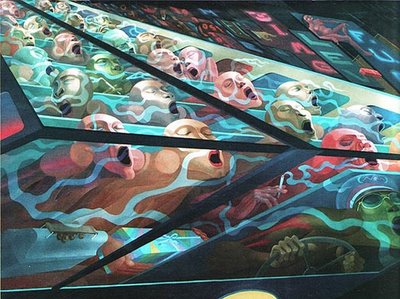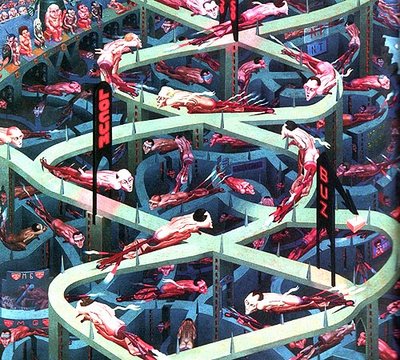Irving Norman in Conversation with Roberta Loach

The Bus © Irving Norman 1953
(Click on image for larger view).
All images in this series are presented with Hela Norman's permission.
I'd like to share with you an interview artist Roberta Loach did with Irving Norman back in 1975. It isn't often you get to really see inside an artist's head but this interview is a great window into Norman's motivations and experiences. Perhaps only another artist knows the right questions to ask, but I find this exchange between Norman and Loach to be fascinating and inspiring, I hope you will too. It's a bit long so I've broken it up into three parts with more of Norman's amazing images. Here is the first installment:
Along the California coast a winding road leads inward to the small cottage of Hela and Irving Norman. The natural, unassuming environment seems to befit the nature of the artist... a robust, vital looking man in his middle years. His energetic appearance is expected when keeping in mind the great amount of effort involved in executing his large oils with their painstakingly accurate detail and profound humanistic statements. His paintings and drawings reveal a life long study of the human anatomy and careful application of such knowledge. His highly complex compositions are composed with a sense of perfection and daring in design. Norman's colors have appeal and even beauty, but their primary concern is to enhance the concepts he puts forth. He is a brutally honest, straightforward man and a pleasure to talk with as he can't be bothered with indecipherable esoteric jargon or the luxury of temperament. He is just concerned with doing and being, living, loving and embracing live to the fullest.
Roberta Loach: Mr. Norman...do you consider yourself a moralist?
Irving Norman: I don’t know what you’re definition of a moralist is unless you see it as getting angry at some things that are done to people that are not good.
RL: I would call a moralist someone with a strong social concern.
IN: Yes, that's what I am. I'm affected by what happens to people, and deeply.
RL: Have you always been?
IN: Yes, I was brought up that way. My education was in the left wing movement in New York during the 30's. It taught me not to be so self-centered but to be concerned about the world...to be aware of the connection of your personal life with the world. I became conscious of what happens to people, globally.

Rush Hour on the Corner of..., © Irving Norman 1977
(Click on image for larger view).
All images in this series are presented with Hela Norman's permission.
RL: When did this consciousness take its form in your experience as an artist?
IN: That came after my war experience. I was looking, seeking a way to express myself. I discovered a love of drawing that I had as a child and since I had a great deal on my mind that I wanted to express, I turned to this medium. My war experience taught me about the oppressiveness of the power structure in its extreme form. At this stage in human development it struck me as a horrible irony that all of the best in science and technology was directed towards destroying people. I wanted to have something to say about this. I turned to art...I discovered my medium slowly.
RL: Did you have much formal training?
IN: Not much. I studied at the San Francisco Art Institute, won the Bender Award, which enabled me to return to New York to study at the Art Student's League. I studied with Reginald Marsh. He wasn't a good teacher, but I liked the way he handled the figure. I also had great enthusiasm and admiration for Robert Beverly Hale in his great class in anatomy and drawing. I wanted to learn to relate the figure to the environment. That is why there is so much environment in my work.
RL: Do your figures come out of your experience as an artist?"
IN: Yes, for the most part. My structure of the figure is due to my study of it, but sometimes when I need a certain type of figure, I refer to a model or photo in a magazine.
RL: Do you ever find yourself using the same figure over and over again...getting into a pattern of cliché figures?
IN: No, that is I'm not conscious of it. What determines my composition of figures is usually the space they are confined in and what they do...just like in real life.

The Race © Irving Norman 1962
(Click on image for larger view).
All images in this series are presented with Hela Norman's permission.
RL: Do you see art as an ongoing process...tied up with life?
IN: Oh yes...there is no other source...even the most abstract work is related to life except it's related to certain segments, to certain philosophies, a certain way of thinking at a certain time in the development of a country. It's interesting...a current issue of the New York Times had a n interesting article on Russian painters of the beginning of this century. The collector who collected those works saw the beginnings of what came in the U.S. fifty years later. The style of Jackson Pollock, and others was evident then. The reason I mention this is because it shows the relationship between art and the state of society. The point that I'm trying to make is that contemporary abstract art and where it leads to is definitely an expression of the ideological state of the intellectual leadership of Western society. I wasn't wondering if it may not lead to the same conclusion that it led to in Russia...but people forget that. People stay away from that sort of thing. They think art comes from the heavens.
RL: Of course, you may be aware that work such as yours, i.e. of a more humanistic nature, is making some inroads today.
IN: I've heard of it, but I haven't see it.
RL: Oh yes it's emerging and it's refreshing to see. I think, however, that there is a great effort on the part of many elitist types museum curators to suppress it...I guess I shouldn't use that word.
IN: Oh no, you can use that word...it's valid.
RL: I think the big reason as to why work such as yours is rarely shown in the museums is that most curators don't understand it and what goes into it.
IN: That's possible, they have been brought up on a whole generation of the French School of art and it's existentialism. And when you get conditioned in a certain outlook, it takes a highly original person to break away from this and recognize truly original work.
More to follow next time.
Previous installments of this series can be found here:
Part 1
Part 2
See Irving Norman's paintings and drawings live and in person on exhibit now in Sacramento, CA. This rare opportunity to see some of the painter's best works, at The Crocker Museum ends January 7, 2007.
Note: If you're unable to see Norman's work in person you may want to purchase a copy of the book, Dark Metropolis. It's well written and has large, clear, vivid reproductions of Norman's art.
Please respect the work of the artists you see here and be sure to credit them when you share their artwork with others.
To share your opinion on this or any other post, please click the word "COMMENTS" below.




2 Comments:
Hey Emily,
I've finally found what I've so desperately been looking for - another active political-arts blog!
I've only browsed just a bit, and am very impressed. Your entries seem very comprehensive. You've gained a new regular member!
I'm the blogger/webmaster/writer behind http://othersite.org, a humble arts & politics blog. I'm quite new on the blogging scene, so my archives are fairly empty. I was hoping you could point me to other, similar blogs, so I could network a bit more.
Anyways, I'll be sure to leave comments in the future, and I look forward to reading what you have to share!
Take care.
Hello Other,
Thanks so much for stopping by my blog. It is indeed good to find another political-art blogger. I've visited your site and enjoyed what you have up so far. I await more installments but...I understand the challange of coming up with content so no pressure! It would be nice if you added some information about your own background to your blog, unless staying mysterious is part of the type of discussion you wish to encourage on your site. I look forward to seeing what you do next.
-Emily
Post a Comment
<< Home